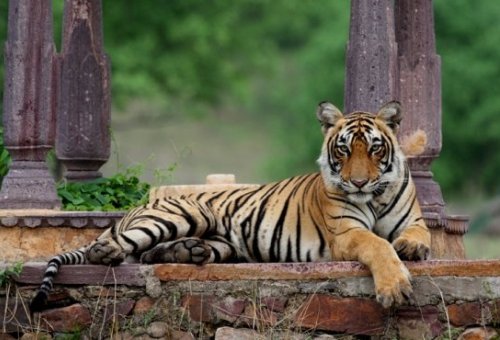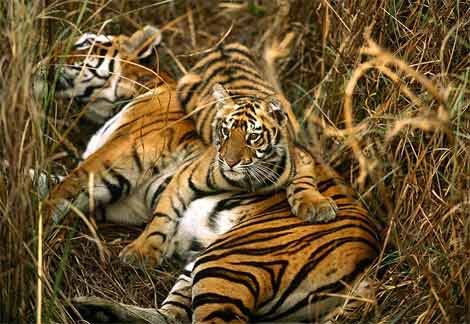The Hawaii state animal, which is a bird called the "Nene", is a strange and unassuming fowl. The name is pronounced "nay-nay". Upon first glance the fowl looks like a cross between a goose, a duck and a quail, only the tail feathers are not as long as the quail's. One may ask why this bird, out of all the birds available, was chosen as the Hawaii state bird. Well, this is an animal that can only be found in the Hawaiian Islands. The Nene's feathers have been used for decades by the native peoples of the islands in ceremonial dress. However, before the turn of the century, the Nene was stalked by non-native species of animals carried to the islands by pirates, and so became almost extinct by the mid-twentieth century. During this time the state of Hawaii decided to make the Nene the Hawaii state bird.
Thanks to the efforts of the Hawaiian park systems, the Hawaii state animal has been able to reproduce in a protected atmosphere. The park system has ensured its survival by carefully cultivating the animals habitat by planting the plants it enjoys eating, and by sectioning off parts of the parks so that intruders will not harm it. Hopefully the rate of reproduction for this animal will increase, as the numbers have decreased over the decades due to the harsh environment forced upon it by predators. Early on there were only about 50 birds, but now they number between 800 to 1000. Due to hurricanes, some Nene have managed to migrate to Europe, but there the fowl have experienced a decline in health, and the zoos will not utilize these animals to reproduce others. The Nene that were freed from the cages in the storms became wild and have managed to adapt well on one of the Islands in a grassy area, free of one or two traditional predators faced on other islands.
The Hawaii state bird is of the species Branta Sandvicensis, and has been recently understood to be a relative of the Canadian goose via genetic research. Scientists say that the Hawaii state animal originally survived in a mostly wetland habitat, but gradually adapted to the stark landscape of the volcanic islands. The fact that this animal was able to adapt is a tribute to the heartiness of the species. Visitors to the islands over the years have introduced many animal species that have preyed on this fowl, and therefore drastically reduced the overall number of Nene's in the region. At one time, this species was even placed on the endangered list! However, thanks to the efforts of societies that are interested in caring and protecting this fowl, the Hawaii state animal has managed to make a strong come back. God created a great variety of fowls, for both the land and the air. In the Bible it says that God created the fowl of the earth: "And God said, Let the waters bring forth abundantly the moving creature that hath life, and fowl that may fly above the earth in the open firmament of heaven" (Genesis 1:20 KJV).
Of the geese in Canada, only two subspecies are most closely related to the Hawaii state bird. Researchers first began research on ancient fossils, and compared the DNA in the fossils to that of the modern Nene. The scientists found close similarities, and began looking at goose DNA from other species to see how they were all related. The longer a species has been around, the more changes there are in the DNA over time. The Hawaii state animal can be distinguished from other geese by its distinctive markings. Unlike the Canada goose, the Nene has lighter colored cheeks, and gold tipped feathers. The Nene also has a smaller stature or body than other geese. Those who are very familiar with ducks and geese and their markings, however, should have little problem identifying this Hawaiian state bird on first glance.
Bird watchers will find the Nene to be an interesting study, and will also enjoy its call, which is said to be calm and soothing, unlike it's cousin the Canadian goose, whose call is quite loud but distinctive. Of all the places in the Hawaiian Islands to bird watch, Kauai is the best location to watch for the Nene. The Hawaiian Audubon Society can help out anyone wishing to discover all the best areas to watch for the Nene, and for any other Hawaiian bird for that matter. This organization should be able to give the complete history of how this species migrated to the islands, and how it has managed to survive despite the odds against it. There are even ornithological maps for those die-hards determined to discover this rare fowl in all of its glory. Studying this animal should be a treat not soon forgotten.
The Hawaiian state bird should provide many fun hours of watching for the kids too! There is no reason for children not to learn about nature in this way. This is a great activity for parents to do with their children to spend quality time with them, and to bolster their creativity and natural curiosity about the world. So take advantage of the opportunities that this wonderful bird can afford the family, and read about this animal in the encyclopedia, bird watching magazines, scientific articles and other educational venues before hitting the trail into the wilderness to observe. The research done before hand will only serve to enrich the experience and make the trip a memorable one for the whole family.
Thanks to the efforts of the Hawaiian park systems, the Hawaii state animal has been able to reproduce in a protected atmosphere. The park system has ensured its survival by carefully cultivating the animals habitat by planting the plants it enjoys eating, and by sectioning off parts of the parks so that intruders will not harm it. Hopefully the rate of reproduction for this animal will increase, as the numbers have decreased over the decades due to the harsh environment forced upon it by predators. Early on there were only about 50 birds, but now they number between 800 to 1000. Due to hurricanes, some Nene have managed to migrate to Europe, but there the fowl have experienced a decline in health, and the zoos will not utilize these animals to reproduce others. The Nene that were freed from the cages in the storms became wild and have managed to adapt well on one of the Islands in a grassy area, free of one or two traditional predators faced on other islands.
The Hawaii state bird is of the species Branta Sandvicensis, and has been recently understood to be a relative of the Canadian goose via genetic research. Scientists say that the Hawaii state animal originally survived in a mostly wetland habitat, but gradually adapted to the stark landscape of the volcanic islands. The fact that this animal was able to adapt is a tribute to the heartiness of the species. Visitors to the islands over the years have introduced many animal species that have preyed on this fowl, and therefore drastically reduced the overall number of Nene's in the region. At one time, this species was even placed on the endangered list! However, thanks to the efforts of societies that are interested in caring and protecting this fowl, the Hawaii state animal has managed to make a strong come back. God created a great variety of fowls, for both the land and the air. In the Bible it says that God created the fowl of the earth: "And God said, Let the waters bring forth abundantly the moving creature that hath life, and fowl that may fly above the earth in the open firmament of heaven" (Genesis 1:20 KJV).
Of the geese in Canada, only two subspecies are most closely related to the Hawaii state bird. Researchers first began research on ancient fossils, and compared the DNA in the fossils to that of the modern Nene. The scientists found close similarities, and began looking at goose DNA from other species to see how they were all related. The longer a species has been around, the more changes there are in the DNA over time. The Hawaii state animal can be distinguished from other geese by its distinctive markings. Unlike the Canada goose, the Nene has lighter colored cheeks, and gold tipped feathers. The Nene also has a smaller stature or body than other geese. Those who are very familiar with ducks and geese and their markings, however, should have little problem identifying this Hawaiian state bird on first glance.
Bird watchers will find the Nene to be an interesting study, and will also enjoy its call, which is said to be calm and soothing, unlike it's cousin the Canadian goose, whose call is quite loud but distinctive. Of all the places in the Hawaiian Islands to bird watch, Kauai is the best location to watch for the Nene. The Hawaiian Audubon Society can help out anyone wishing to discover all the best areas to watch for the Nene, and for any other Hawaiian bird for that matter. This organization should be able to give the complete history of how this species migrated to the islands, and how it has managed to survive despite the odds against it. There are even ornithological maps for those die-hards determined to discover this rare fowl in all of its glory. Studying this animal should be a treat not soon forgotten.
The Hawaiian state bird should provide many fun hours of watching for the kids too! There is no reason for children not to learn about nature in this way. This is a great activity for parents to do with their children to spend quality time with them, and to bolster their creativity and natural curiosity about the world. So take advantage of the opportunities that this wonderful bird can afford the family, and read about this animal in the encyclopedia, bird watching magazines, scientific articles and other educational venues before hitting the trail into the wilderness to observe. The research done before hand will only serve to enrich the experience and make the trip a memorable one for the whole family.
For more information: http://www.christianet.com/hawaiicruises








0 comments:
Post a Comment